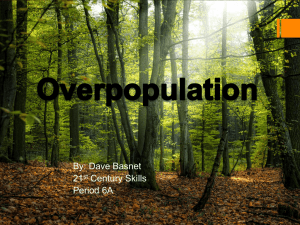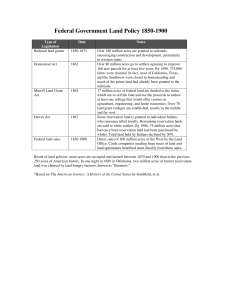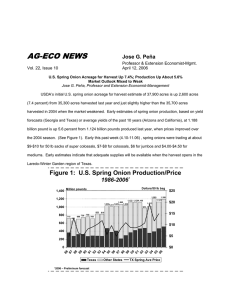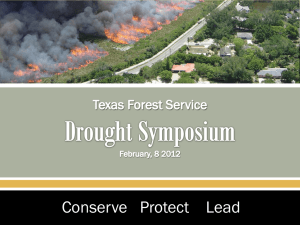presentation source
advertisement
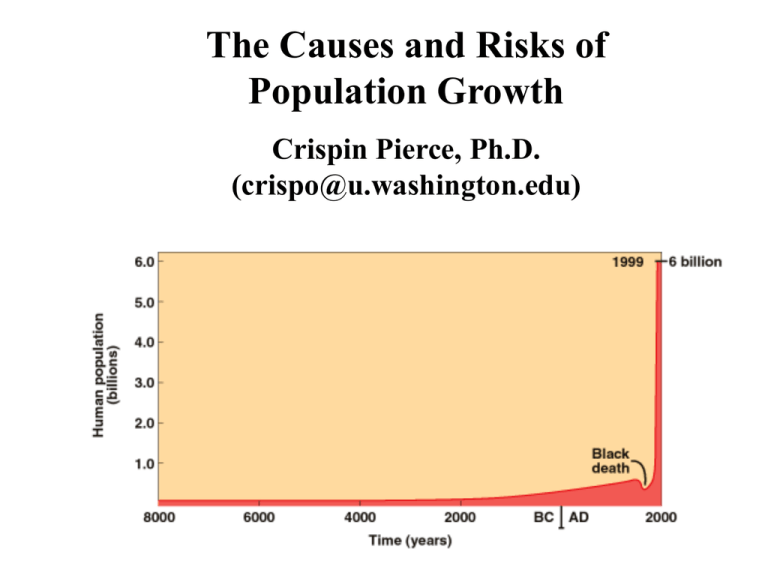
The Causes and Risks of Population Growth Crispin Pierce, Ph.D. (crispo@u.washington.edu) “Unlike plagues of the dark ages or contemporary diseases we do not understand, the modern plague of overpopulation is soluble by means we have discovered and with resources we possess. What is lacking is not sufficient knowledge of the solution but universal consciousness of the gravity of the problem and education of the billions who are its victim.” Martin Luther King, Jr., 1929-1968 “The list of environmental problems aggravated by growing populations includes deforestation and desertification, loss of topsoil, poisoning of drinking water and pollution of oceans, shrinking wetlands, shortage of fuels such as firewood, exhaustion of oil reserves and of various mineral resources, siltation in rivers and estuaries, dropping water tables, erosion of the ozone layer, loss of species and wilderness areas, global warming, rising sea levels, nuclear waste, air pollution, and acid rain.” Rebecca Clay, Environmental Health Perspectives, vol. 103 (1995). “Currently the U.S. has no policy on population — even though both the Rockefeller Commission in 1972 and the President’s Commission on Sustainable Development in 1995 recommended that the U.S. adopt policies to stabilize the U.S.’s population.” COPHP Student, 2003 Overpopulation exists if the activities of the current population are depleting the capacity of the environment to provide for future populations. • • • • • How fast is population size increasing? What are the causes of increase? What are the effects of increase? Population increase myths. Which tools are effective at slowing population increase? • What can I do? How fast is population size increasing? • Currently at 274 million, the U.S. population is growing by about 2.5 million people each year, making the United States one of the world's fastest-growing industrialized nation. The U.S. fertility is currently at 2.0, up from 1.8 in 1988. • Immigration adds at least another 800,000 people annually to our nation's population. What are the causes of increase? • Improved medicine, sanitation, and nutrition have produced a major decline in death rates, particularly in the last century. For example, life expectancy in Egypt increased by twenty years between 1940 and 1960. • Birth rates have declined much more slowly. • Households in rural areas of developing countries often have little or no assurance that they will receive an income when old: there is no social security system, no employer subsidized funds, no medical insurance or life insurance. Children may be viewed as an asset which will generate income when the parents are old. • In many countries, the degraded status of women is another contributing factor to high birthrates. Women are often denied opportunities for education, employment, land ownership, and governmental service. As a result, they have few alternatives to their childbearing roles. • Developing areas such as Africa, Latin America and parts of Asia are still primarily agrarian; therefore, incentives for having larger families still exist. • Following adoption of basic technology that improved living conditions, death rates plunged dramatically. As a result, these populations are growing rapidly. Why do households have more children than may be best for society? • People may not recognize the implications of falling death rates for their fertility decisions. • Family size choices may have consequences for other families that are not considered. For example, publicly funded education, child care, tax deductions, and child welfare programs. Similarly, congestion costs of overpopulation and • For large extended families that are typical in rural areas, there are often perceived decreased costs associated with having children. For example, the private costs of a child to one mother may be lower if she expects her sister to help in child rearing. • Societies and religions have developed social norms to encourage child rearing (e.g. celebration of childbirth), and to discourage birth control. What are the effects of increase? • As human population increases, the diversity and number of plants and animals decreases. We lose one or more entire species of animal or plant life every 20 minutes – 27,000 species a year. This is a rate and scale of extinction greater than any in the last 65 million years. • “Six million acres of prime farmland – an area the size of Vermont – were lost in the United States alone between 1982 and 1992. Four of those six million acres were lost to urban and suburban expansion. The other 2 million acres were lost through erosion caused by deforestation, unsustainable farming practices, and animal over-grazing.” • Global carbon dioxide emissions have quadrupled since 1950, largely from deforestation and the burning of fossil fuels. This “greenhouse gas” addition causes global warming and disruption in weather patterns. – Five storms over the span of five years have cost the insurance industry in the United States $25.7 billion. – Increased spread of malaria, cholera, typhoid fever, and dengue fever worldwide are expected. Population increase myths. • “Per capita food production is increasing, so the Earth must be able to sustain population growth.” • Per capita meat production has increased: • Per capita production of grains has decreased since 1984: • It takes 23 times more water, and ten times more energy to produce one ton of beef than it does to produce one ton of grain. • Current unsustainable agricultural practices have led to widespread cropland losses and extensive water pollution from pesticides and fertilizers (e.g., the Mississipi River and the death zone in the Gulf of Mexico). • “Technology and market forces will provide solutions to problems associated with population increase.” – “As populations grow, especially in rural areas, increased scarcity of land (and other resources) may drive people to innovate and adopt new methods and technologies that use them more efficiently. It is often argued, for example, that the agricultural revolution in the UK and other European countries after 1650 was driven by population growth.” • Market systems subsidize industries such as logging, mining and grazing without considering environmental costs. Degradation of commonly held resources such as groundwater levels or atmospheric and ocean quality is not included. Nor do markets consider Earth's "services," such as regulation of climate, detoxification of pollutants or provision of pollinators, much less questions of human equity and social justice. • “The entire population of the world could fit into an area the size of Texas.” • Dividing the world's 6 billion humans into Texas's 261,914 square miles, each person would have 0.028 acres of land. However this land in Texas, (or even all the land in North America for that matter), would not be able to sustain these people. A minimum of 0.17 acres of arable land is needed to sustain a person on a largely vegetarian diet without the intense use of fertilizers and pest controls. • The tiny amount of land per person in the Texas scenario could not accommodate the intense demands we place on our lands (particularly in developed countries): roads, businesses, grazing lands, lawns, airports, etc. Group Projects • Exponential Growth Questions • Questions of Freedom • The Economic Costs of Population Growth Exponential Growth Questions • Would you rather receive $10,000, or the amount after thirty days, where you receive one cent on day one, two cents on day two, four cents on day three, etc.? • If the current rate of world population increase is 1.31%, how many additional people will inhabit the planet in one year? • Which costs would you include in the price of gasoline to adequately reflect the natural resource costs of petroleum exploration, development, and use? Questions of Freedom • Which freedoms in American society decrease with increased numbers of people? • Are there freedoms that are increased with increased population density? • Who should decide on losses of freedom vs. population stabilization? The Economic Costs of Population Growth • There are three major areas of U.S. taxation: property taxes, income taxes, and sales taxes. Which of these taxes is disproportionally spent (but not collected) on families with large numbers of children? Which of these taxes is disproportionally lower for families with large numbers of children? • Should municipal entities, such as schools, city boundaries, and water and sewage systems be designed and built for a target population size? Should additional residents (born children and/or migrants) have to live elsewhere once a city has reached its maximum size? Which tools are effective at slowing population increase? • Improve the health of women and children. – Improved family planning supports women in choosing to delay motherhood, prevent unwanted pregnancies, and avoid STDs (including AIDS) and dangerous abortions. Improved family planning could reduce child and infant mortality by 25%, preventing three million deaths per year. • Guarantee access to family planning resources. • Eradicate violence against women. – Abused women are afraid to use family planning services for fear of reprisal from their husbands. • Educate and involve men in family planning and child care. • Create gender equity. – Insist on women’s rights to own property, to get an education, to earn income, and to participate in government. • Actively conserve cropland, freshwater, energy, and other environmental resources. What can I do? • Plan the size of my family. Consider having two or fewer children, and/or adoption. • Support domestic and international family planning programs. • Become involved in programs supporting equal rights, and educational and job opportunities for women worldwide. • Conserve energy and natural resources (one U.S. citizen consumes about 30 times as much as a citizen of India). • Encourage reduction of western patterns of consumption. – The richest fifth of the world consumes 86% of all goods and services and produces 53% of all carbon dioxide emissions, while the poorest fifth consumes 1.3% of goods and services and accounts for just 3% of C02 output. References Zero Population Growth The Union of Concerned Scientists Cornell University PregnantPause
